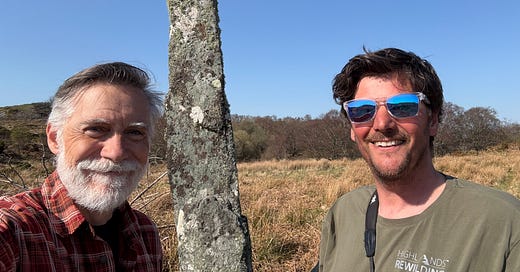For the final stop of my rewilding fact-finding mission across Scotland I got to spend a few stunningly beautiful days on the near-magical Tayvallich peninsula, one of Highlands Rewilding’s three rewilding estates.
The weather was - and would remain - ridiculously beautiful and balmy when I drove five hours south, from Shieldaig through Fort William, Inveraray and Lochgilphead. From there it was another eleven miles, through increasingly adventurous remoteness, to the beautifully secluded village of Tayvallich. From there another four miles of single-track road that further redefined remoteness - and that’s where my temporary home, in the middle of the Tayvallich peninsula, awaited.
The land that sings
Some of the time there was given to catching up on writing about my many previous experiences. But most of it went to solo excursions that fueled my imagination. I’d love to write a book of fantastical tales and mythical sagas set on mystical Tayvallich - the lands and waters seemed, to me, to practically demand that such stories be written. And then of course there was also a most enjoyable and illuminating afternoon in the company of estate manager Ewan Paterson, for whom the peninsula has been home for nearly two decades.
Some landscapes I’ve seen are so degraded that you can almost hear the cry for help, landscapes where “conservation” would be a cruel joke, where active rewilding is an absolute necessity to give nature the chance to recover. Tayvallich is none of that. Walking on my own, it felt like the place was singing to me in peaceful and contented harmonies.
Some of what I’ve seen really does have a veritable fairy tale character. There are stunning views, solitary paths, ancient standing stones, burial cairns, knotted woodlands, croft ruins, fantastical rock formations. There’s the sound of Jura on one side, Loch Sween on the other - and lots of lush nature in between.
Baselining Tayvallich
Any rewilding efforts on Tayvallich start from a - all things considered - very good place. Highlands Rewilding’s efforts there have really only just begun. The company started its operations with the purchase of Bunloit (👉 read about my visit there), followed by Beldorney - with Tayvallich making it a trio of estates in 2023.
The first year was essentially spent baselining, assessing the biodiversity within the estate, as well as gauging the amount of Tayvallich’s carbon storage. The results have been published in Highland Rewilding’s 4th annual natural capital report.

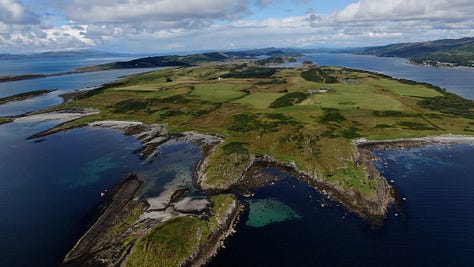

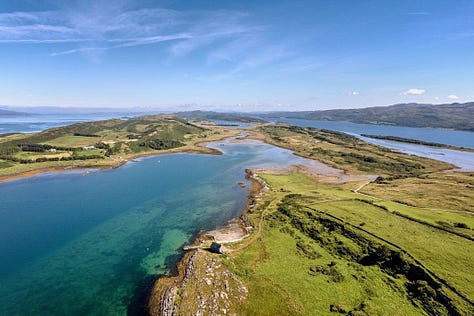
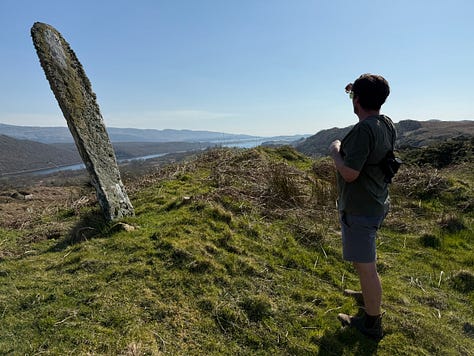

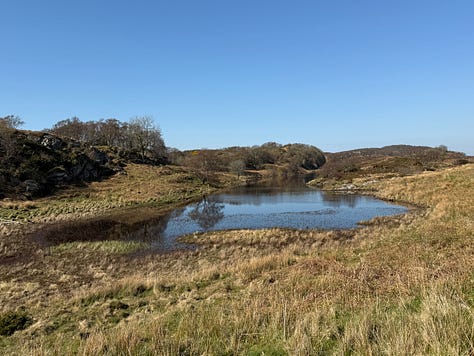
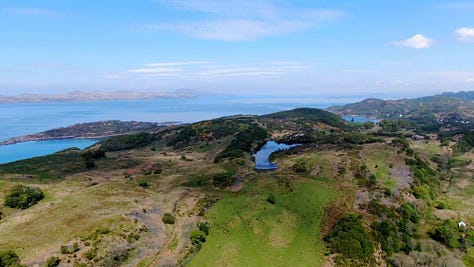

Even if you’ve just looked at some of the above pictures, you won’t be surprised to learn that a peninsula with over forty kilometers of varied coastline - open sea (the Sound of Jura), sea loch (Loch Sween), inlets (Linne Mhuirich) and lochans - and with native woodlands, grasslands, wetlands and heathlands, are a haven for biodiversity.
The reports confirms that the mosaic of habitats is “home to many species of special conservation importance and concern, with this year’s surveys recording 17 birds on the Red List of conservation concern, 31 on the Amber List, and surveying one of the few remaining strongholds of the rare and protected Marsh Fritillary butterfly.”
Oh, deer!
Highlands Rewilding’s very own ranger and farmer Erik Riddell is dedicated to regenerative farming. Grazing by both sheep and cattle has its place and I always love it when I see that nature restoration efforts embrace the mantra of nature and people - there should always be a solid balance that enriches both, rather than harms one side to the detriment of the other. At first glance, then, one might think that all’s well - even on second glance. But there are challenges, both on land and below the surface of the waters. On land the main challenge is, as ever so often in Scotland, an abundance of deer.
When I explored Tayvallich with Ewan, we saw a few. A 2024 thermal imaging survey showed around 300 deer. Highlands Rewilding’s report explains that this amounts to 21 deer per square kilometer, a number far too high for any native woodland to have a chance to regenerate naturally. On the Glenfeshie estate (another one of my visits), they’ve been culling deer consistently for years now and have brought the numbers down to just 2 per square kilometer - and native woodlands flourish.
Deer culling is ongoing at Tayvallich - and Ewan hopes that they can eventually turn this necessity into a venison usiness. As I’ve seen time and time again over the course of the past three weeks, there’s no way around it. Ewan told me that they’re planning on planting some 800’000 trees - for these to grow, to enrich the land, to increase biodiversity and to offer greater connectivity for woodland creatures, deer must be kept in check.
Before focusing on troubles in the water - one more thing on deer: I knew that they can swim, but I had no idea just how well they can swim. The Sound of Jura - the waterway between Tayvallich and the island of Jura - is nearly five kilometers wide. Ewan told me that fishermen have seen deer swim all the way across!
You may wonder why I’m mentioning this particular bit of trivia. Well, here’s why: If you want native woodlands to recover, you need to protect saplings (whether naturally grown or planted). You can either protect them by bringing deer numbers down, or by putting up deer fences. You see where this is going, right? When you have a rewilding estate that is on three sides surrounded by water, fences are not an option and so culling must happen - and will continue to happen. There will always be deer, attracted by Tayvallich’s growing native woodlands.
The disappearance of the oysters
When it comes to the biodiversity of the water world, the surveys have uncovered a surprising problem - the native oysters are practically gone. Subtidal and intertidal surveys have shown that, where 100’000 oysters should have been, a total of just 47 live oysters were found. You read that right, 47. Ewan said that natural causes such as diseases or climate change could be ruled out as potential causes, as very few empty oyster shells were found. Based on the findings it is highly likely that over-harvesting is to blame. Looking across the oysters-depopulated catchment, Ewan said,
“People think that if they take a bucket of oysters, twenty oysters, they won’t do any harm. But if a hundred people do that, and do it over a period of years, then the harm is immense.”
Highlands Rewilding and Seasearch did the surveying. With the findings in hand, marine biologist David Smyth (Highland Rewilding’s Marine Rewilding Lead) calls on authorities to investigate and suggests ways of bringing back oysters in big numbers. I’ve heard that NatureScot (the authority in charge of Loch Sween) may want to do its own survey before taking action. My hope would be that, instead of duplicating and wasting time, they make a decision on a way forward.
Interestingly, within an MPA, you’re obviously supposed to leave nature alone. But in the knowledge that the few remaining oysters can no longer create a spawning event, the way forward would be to take a few thousand oysters from somewhere else and drop them in a cluster into the deep of the loch. Such action would be illegal - unless, of course, NatureScot decides in favor of oysters. Something decisive needs to be done to help the Loch Sween oyster population recover.
A sense of community
Ewan Paterson has been living on the peninsula with his family for nearly two decades. And he’s told me that the community barely knew the estate’s previous owner, that he might walk through the village and most people wouldn’t even recognize him. When the estate came up for sale, Rewilding Highlands founder Jeremy Leggett had a very different approach. He brought people together, talked to everyone, transparently shared his thoughts - and all of that even before the sale had happened - and this sort of community engagement continues.
Highlands Rewilding, in its short time with Tayvallich, has already brought big and highly positive changes for the community and - of course - for nature. They’ve sold 19 hectares to the Tayvallich Initiative (the local community body) and 625 hectares (half of the estate) to the Barrahormid Trust (a local charity). While ownership has changed, objectives have not. The Barrahormid Trust has entered into a long-term management arrangement, with Highlands Rewilding managing the land in accordance with their rewilding mission and principles.
Talking about community - these land sales also make housing a key priority. Local residents can purchase existing houses, and ruined buildings will be brought back, all with the idea of revitalizing the Tayvallich community. Ewan mentioned that the local school sees declining numbers of students. I can definitely imagine that new housing opportunities will bring more families to Tayvallich. And another reason for people to want to move to Tayvallich? Biodiversity-rich nature!
A few final rewilding thoughts
As you might have gathered from my initial gushing paragraphs, I consider Tayvallich quite beautiful. And with the hope that many more people will come and visit this marvelously remote spot (not to cruise by in a camper van, mind you, but to stay a few days and soak in the serenity of the place), here a few final thoughts:
Segmentation: This is a peninsula - as such, it offers excellent options to segment how this or that part is used. While I love Scotland’s “right to roam”, I felt that I was sometimes encroaching on nature. The outer parts of Danna Island, for example. I would consider signage in some places, informing visitors that they are approaching certain areas, such as the nesting grounds of geese or the lazing spots of seals. I think such signage would a) keep visitors at a bit of a distance, b) give nature its breathing space and c) highlight to visitors just what special a place they’re in.
Boar Island: With the peninsula focused on nature restoration, and with the boar still absent, I’d make the boar a visible symbol of Tayvallich. There’s room to spare, boar are amazing creatures and I’ve no doubt they’d love it there. Imagine becoming known as something like “boar island” … and if boar numbers were to grow into the hundreds, well then, boar would join deer as part of Ewan’s wild meat butchery business plans. Oh, and by the way, it goes with Argyll’s history: The Campbells, Dukes of Argyll, have the boar on their very crest.
Beaver heaven: Ewan mentioned that a beaver had already put in an appearance once - but left again in search for a female. One Tayvallich wetland has been identified as a suitable habitat. With NatureScot taking as long as it takes, I’d put in for a license today. Tayvallich, with its travel options across Linne Mhuirich, would be a) heaven for beavers and b) another draw for visitors (and potential newcomers to the Tayvallich community).
And yes, someone definitely has to write that book of fantastical tales and epic sagas that most definitely did take place on Tayvallich!
Cheers,
PS: For more about the estate and its people, check out below clips:
If you enjoy the Rewilder Weekly …
… consider supporting my work. Your paid subscription will help generate the funds needed to realize a unique rewilding book I’m working on. And, of course, that paid subscription also ensures that the Rewilder Weekly will always keep going for those who cannot afford to pay. A thousand thanks!


